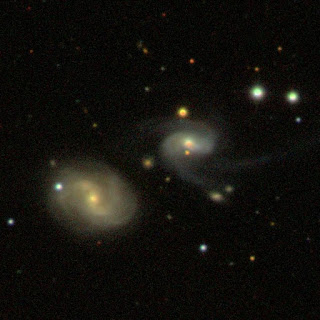January 4. 20" F/5. SQM 21.2, good seeing.
Arp 210, DSS
Arp 210, NGC 1569, Cam. HII.768, reobservation. 13 mm. Greatly extended WNW-ESE, with an elongated core greatly offset to the WNW end. 3 sharp knots along the major axis in the core. Galaxy extends faintly almost to the star ESE. Bright star with a fainter companion N of core.
Arp 52, SDSS
Arp 52, CGCG 421-27, Ori. 8 mm. Faint, small, extended NS with core offset to S [this matches the original blue plate] and NE edge enhanced. Core intermittent and occasionally resolved from a starlike knot (companion) within the halo to NNW. Double star 2.5' NW is partially resolved into a NS pair.
Arp 61, DSS
Arp 61, MCG+0-12-55, Eri. 8 mm. UGC 3105 ~6' E and MGC -53 >1' SW visible, respectively large and elongated and small and round. In -55, core immediately SE of faint star, elongated NW-SE and has an extension to NE of the star, which is offset NE from the major axis. Star of equal magnitude NW of the line between cores of -53 and -55. Star on the line intermittent. Starlike companion off the NW end of -55 similarly intermittent. Star inwards from it is invisible.
Arp 143, SDSS
Arp 143, NGC 2444-2445, Lyn. 8 mm. 2444 more prominent, compact ESE of star. Fainter and smaller compact core to SSE and seems to be involved in the same irregular halo. Faint star is embedded on the S edge of it. Two faint stars farther S. NS double enhancement E to ENE of core of -45. It is separated from core by a dark area. W side of the galaxy is brighter. Second double enhancement is W and NNW of core. S edge immediately W of the faint star is enhanced, ending in a faint compact knot on W side.
Arp 250, SDSS
Arp 250, 2 2MASX galaxies in Lynx. [Actually, PGC 21362 and 2063674.] Main component small, faint, elongated NE-SW, elongated core and faint intermittent extension SW. Threshold star WNW. Equidistant opposite is faint, compact companion, intermittent.
Arp 83, SDSS
Arp 83, NGC 3799-3800. Herschel object reobservation. Leo. 8 mm. 3800 strongly extended NE-SW. Semi-detached star cloud on NE end. NW edge is brighter along the extended core and continues slightly past it to the SW. NGC 3799 immediately farther SW. Compact, comma-shaped with the short tail curving SE and E.




 Reply With Quote
Reply With Quote














